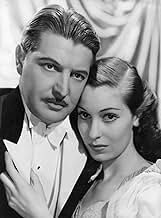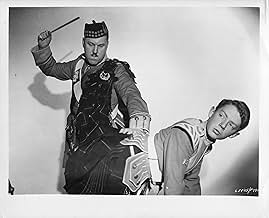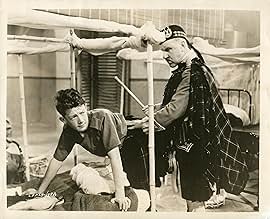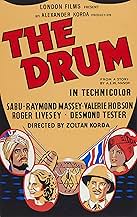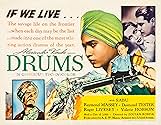VALUTAZIONE IMDb
6,3/10
993
LA TUA VALUTAZIONE
Aggiungi una trama nella tua linguaIn British India, Captain Carruthers investigates arms smuggling on the North West Frontier. The governor makes peace with Tokot's ruler. Prince Azim bonds with Carruthers and learns drums f... Leggi tuttoIn British India, Captain Carruthers investigates arms smuggling on the North West Frontier. The governor makes peace with Tokot's ruler. Prince Azim bonds with Carruthers and learns drums from British boy Bill Holder.In British India, Captain Carruthers investigates arms smuggling on the North West Frontier. The governor makes peace with Tokot's ruler. Prince Azim bonds with Carruthers and learns drums from British boy Bill Holder.
- Regia
- Sceneggiatura
- Star
- Premi
- 1 vittoria e 1 candidatura in totale
Francis L. Sullivan
- Governor
- (as Francis L.Sullivan)
Laurence Baskcomb
- Zarullah
- (as Lawrence Baskcomb)
Julien Mitchell
- Sergeant
- (as Julian Mitchell)
Recensioni in evidenza
The British are trying to make peace treaties with numerous tribes in India to make sure there isn't an uprising among rebel tribes. Captain Carruthers makes a treaty with the prince, but when the prince's brother (Prince Ghul) murders the prince, he now has the tribes just where he wants him (in a spot to annihilate the British). The murdered prince's son (Prince Azul) reaches Carruthers and tells him of what happened, so Carruthers takes a troop to Ghul's fortress. Ghul welcomes Carruthers with a ceremony of a 5 day feast, but when the feast is over Ghul plans to kill all the British troops with their smuggled machine guns, unless Azim can lead a British battalion to Tokot to stop Ghul's mad plan. Despite being politically incorrect with the British superiority over the people of India, the film does contain a fair amount of action and thrills to entertain the film going audience, granted it is no Gunga Din or Four Feathers (the latter of which and this film share the same author). Massey oozes evil as Ghul, and their is decent support with Sabu, youthful as ever as Azim, Massey as the stuffed shirt Carruthers, and Hobson as his wife. The score is decent, but not that rousing and shooting in color limited the best chances to use lighting. Rating, 7.
The film location is always shown as India but in fact part of the film was shot in the snowdonia range of mountains, in a place called Cwm Bychan lake,llanbeder in the county of Gwynedd. My Father was an extra on this film and I noticed that no mention has ever been made that part of the filming was actually done in North Wales
Unabashedly pro-Raj, the story of a young Indian Prince and his friendship with some British army types. The release of this film was reported to have sparked anti-British riots in India. Sabu outdoes himself as the spunky and, ultimately, obsequious Prince who lines up with his friend/occupiers to battle the deliciously evil Raymond Massey. Very politically incorrect by today's standards the film is a good adventure yarn as well as a Korda tribute to the the rapidly vanishing British Empire. The plot borrows elements from the real life killing of Sir Louis Cavagnari and his party years earlier in Afghanistan. In reality British and colonial forces were actively engaged in military operations in Waziristan at the time of the making of the film.
From 'Kim' to 'Carry On up the Khyber', from the famous to the infamous (stand up, Harry Flashman!), the North-West Frontier has proved a fertile source of conflict both fictional and historical... and deposed rulers and fiery mullahs have figured largely from that day to this. The plot of 'The Drum' cribs heavily (and at one point openly, with an impudently-inserted piece of dialogue listing the historical parallels that had been niggling at me!) from real-life events, especially in Afghanistan, and as other stories before and since have been based on the same material, this can result in a certain 'seen-it-all-before' sensation. But the winning element in this film is the touch of humanity and humour which helps the characters to become more than cardboard templates, from the drummer-boy and his misfortunes to the wry jests of the newly-appointed British representative walking open-eyed into a trap. Not to mention that, after a spate of films with seemingly pointless titles, I found it obscurely satisfying to encounter one where the eponymous instrument is actually significant both to the plot and its climax!
The always-excellent Sabu steals the film, as ever, in his role first as a self-possessed princeling and then as a fugitive in exile from his throne; the romantic leads, while well-performed, are less memorable. The tension in the banquet scene is tangible, and Raymond Massey as the usurper brings brains as well as menace to his role. The one element that rather shocked me -- with the exception of the inadvertent glimpse of buttock that reveals exactly what Scotsmen do or don't wear under their kilts! -- was the scene in which the said usurper is shot down by our wounded hero in cold blood, having thrown down his weapon. It's not customary for such an act to be depicted in an apparently approving manner; and certainly not in a film of this period...
I must admit that the question of the period itself had me slightly puzzled, although the mention of syncopation in the drum part for the dance should have given me a clue. I had automatically assumed the story to be set in nineteenth-century India in the heyday of the Raj rather than the contemporary world, and with few European civilian fashions on display, there was nothing to disabuse me of this until the heroine made an appearance in jodhpurs, which came as something of a shock! (And the subconscious resonance with the valleys of 'Carry On up the Khyber' turns out to be based in fact: locations from both were shot in Wales...)
But 'The Drum' is a rousing adventure as they used to make 'em, in the tradition of 'Charge of the Light Brigade' or 'Northwest Frontier'; if you like the genre, this one is a cracker.
The always-excellent Sabu steals the film, as ever, in his role first as a self-possessed princeling and then as a fugitive in exile from his throne; the romantic leads, while well-performed, are less memorable. The tension in the banquet scene is tangible, and Raymond Massey as the usurper brings brains as well as menace to his role. The one element that rather shocked me -- with the exception of the inadvertent glimpse of buttock that reveals exactly what Scotsmen do or don't wear under their kilts! -- was the scene in which the said usurper is shot down by our wounded hero in cold blood, having thrown down his weapon. It's not customary for such an act to be depicted in an apparently approving manner; and certainly not in a film of this period...
I must admit that the question of the period itself had me slightly puzzled, although the mention of syncopation in the drum part for the dance should have given me a clue. I had automatically assumed the story to be set in nineteenth-century India in the heyday of the Raj rather than the contemporary world, and with few European civilian fashions on display, there was nothing to disabuse me of this until the heroine made an appearance in jodhpurs, which came as something of a shock! (And the subconscious resonance with the valleys of 'Carry On up the Khyber' turns out to be based in fact: locations from both were shot in Wales...)
But 'The Drum' is a rousing adventure as they used to make 'em, in the tradition of 'Charge of the Light Brigade' or 'Northwest Frontier'; if you like the genre, this one is a cracker.
A wicked Khan plans to use THE DRUM perched high up in his palace walls to signal the massacre of British soldiers invited to a banquet.
Sir Alexander Korda's London Films was responsible for this lively Technicolor action film which boasted outdoor scenes shot near the North-West Frontier with the assistance of the Mehtar of Chitral. It blends excitement, humor & history - definitely from a British viewpoint - into an attractive package sure to entertain the viewer lucky enough to find it.
Indian actor Sabu stars as the young Prince of Tokot who finds his life suddenly become very dangerous when he's forced to flee his usurping uncle and accept protection from the British Raj. Plummy-voiced Roger Livesey plays the Raj's stalwart envoy to Tokot who must find a way to stop the import of weapons to the evil new Khan, Raymond Massey, who is fomenting a rebellion. All three actors play their parts very well, with Massey especially attacking his villainous role with gusto.
Also in the cast are Valerie Hobson as Livesey's courageous wife; David Tree as a junior officer; and corpulent Francis L. Sullivan as the local Governor in Peshawar. Alfred Goddard appears unbilled as the hapless private Kelly.
*************************
Born Sabu Dastagir in 1924, Sabu was employed in the Maharaja of Mysore's stables when he was discovered by Korda's company and set before the cameras. His first four films (ELEPHANT BOY-1937, THE DRUM-1938, THE THIEF OF BAGDAD-1940, JUNGLE BOOK-1942) were his best and he found himself working out of Hollywood when they were completed. After distinguished military service in World War II he resumed his film career, but he became endlessly confined for years playing ethnic roles in undistinguished minor films, BLACK NARCISSUS (1947) being the one great exception. His final movie, Walt Disney's A TIGER WALKS (1964) was an improvement, but it was too late. Sabu had died of a heart attack in late 1963, only 39 years of age.
Sir Alexander Korda's London Films was responsible for this lively Technicolor action film which boasted outdoor scenes shot near the North-West Frontier with the assistance of the Mehtar of Chitral. It blends excitement, humor & history - definitely from a British viewpoint - into an attractive package sure to entertain the viewer lucky enough to find it.
Indian actor Sabu stars as the young Prince of Tokot who finds his life suddenly become very dangerous when he's forced to flee his usurping uncle and accept protection from the British Raj. Plummy-voiced Roger Livesey plays the Raj's stalwart envoy to Tokot who must find a way to stop the import of weapons to the evil new Khan, Raymond Massey, who is fomenting a rebellion. All three actors play their parts very well, with Massey especially attacking his villainous role with gusto.
Also in the cast are Valerie Hobson as Livesey's courageous wife; David Tree as a junior officer; and corpulent Francis L. Sullivan as the local Governor in Peshawar. Alfred Goddard appears unbilled as the hapless private Kelly.
*************************
Born Sabu Dastagir in 1924, Sabu was employed in the Maharaja of Mysore's stables when he was discovered by Korda's company and set before the cameras. His first four films (ELEPHANT BOY-1937, THE DRUM-1938, THE THIEF OF BAGDAD-1940, JUNGLE BOOK-1942) were his best and he found himself working out of Hollywood when they were completed. After distinguished military service in World War II he resumed his film career, but he became endlessly confined for years playing ethnic roles in undistinguished minor films, BLACK NARCISSUS (1947) being the one great exception. His final movie, Walt Disney's A TIGER WALKS (1964) was an improvement, but it was too late. Sabu had died of a heart attack in late 1963, only 39 years of age.
Lo sapevi?
- QuizThe film caused protests when shown in Bombay and Madras, as it was considered by many to be British propaganda.
- Versioni alternativeVersion shown on Turner Classic Movies from "The Criterion Collection" runs 93 minutes
- ConnessioniFeatured in Family Classics: Family Classics: The Drum (1964)
I più visti
Accedi per valutare e creare un elenco di titoli salvati per ottenere consigli personalizzati
- How long is The Drum?Powered by Alexa
Dettagli
- Tempo di esecuzione
- 1h 44min(104 min)
- Proporzioni
- 1.37 : 1
Contribuisci a questa pagina
Suggerisci una modifica o aggiungi i contenuti mancanti

